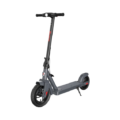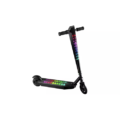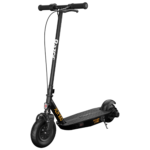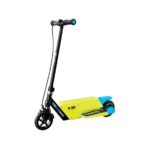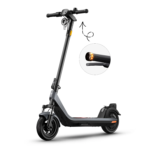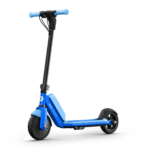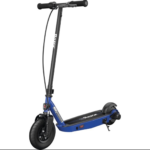- Home
- Scooters
- Electric Scooters
- Razor Black Label E90
Razor Black Label E90
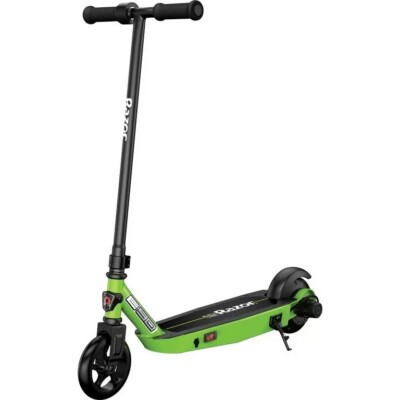



- Battery Range: 10 mi (16 km)
- Top Speed: 10 mph (16 km/h)
- Motor Power: 90 W nominal
- Weight Capacity: 120 lb (54 kg)
- Charging Time: ~4–5 h
- Scooter Weight: 21.5 lb (9.8 kg)
PROS
- Sleek Black Label styling
- Kid-friendly 10 mph cap
- Low-upkeep hub motor
- Solid, flat-resistant tires
- Lightweight and easy to carry
CONS
- Not for adults
- Shorter range
- No suspension
- Lower weight capacity

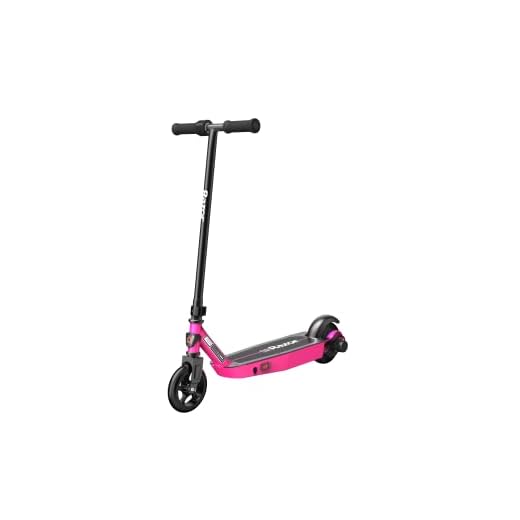
Table of contents
- What Is the Razor Black Label E90?
- How the Razor Black Label E90 Works
- Key Specifications
- Design & Build Quality
- Performance Fundamentals
- Battery, Range & Efficiency
- Ride Quality & Comfort
- Braking & Safety Features
- Portability & Daily Usability
- Maintenance & Care
- Weather & Seasonal Considerations
- Razor Black Label E90 vs Alternatives
- Who the Razor Black Label E90 Is (and Isn’t) For
- FAQs
- Glossary
- Final Thoughts
The Razor Black Label E90 is a lightweight, youth-class electric scooter built for short neighborhood rides and supervised fun. It favors simplicity, easy controls, and durable parts over speed records. Because of that balance, the Razor Black Label E90 suits new riders who want a dependable first e-scooter, as well as parents who value predictable behavior and straightforward maintenance.
What Is the Razor Black Label E90?
The Razor Black Label E90 is a compact, single-motor kids’ scooter designed for short, repeatable trips—think cul-de-sacs, driveways, sidewalks where permitted, and park paths. It emphasizes a steady learning curve. The deck sits low, the cockpit is uncluttered, and the throttle is simple. As a result, new riders spend less time figuring out controls and more time learning basic balance and braking skills.
Although many adult scooters chase long range and high top speed, the Razor Black Label E90 takes a different path. It prioritizes approachability and robust construction. The frame and deck feel sturdy, the wiring is tidy, and the motor’s output is tuned for predictable launches rather than sudden bursts. Therefore, the scooter builds confidence step by step. First you kick, then you ease on the throttle, and finally you get used to steering inputs at a modest pace.
Because it occupies the youth category, its power system, brakes, and tires are chosen to keep weight low and maintenance simple. You will not find exotic dual-suspension hardware here. Instead, you get a sensible setup that tolerates everyday scrapes and the occasional beginner mistake. When matched with proper supervision and local rules, the Razor Black Label E90 becomes a practical tool for developing riding habits that will carry into later, more capable platforms.
How the Razor Black Label E90 Works
The easiest way to understand the scooter is to picture a self-contained electric drive bolted into a small frame. Each core part plays a clear role:
- Motor: A rear hub motor provides gentle, consistent push. Because the motor sits inside the wheel, there are no chains or belts to tension. That design keeps the scooter quiet and reduces moving parts that need attention. Think of it like a compact, sealed “assist” unit that nudges you forward once you get rolling.
- Controller: The controller is the scooter’s brain. It meters power from the battery to the motor so launches feel even and cruising remains stable. It also limits peak output to youth-appropriate levels. Imagine a careful chaperone who says “yes” to smooth acceleration and “not so fast” to abrupt throttle grabs.
- Battery: A sealed, youth-class battery stores energy for short local outings. It is sized to balance runtime with overall weight so the scooter stays easy to handle. Charge it after rides, and it will be ready for the next session. As with any battery, temperature and terrain influence how far you can go on a charge.
- Throttle: A simple hand control sends a signal to the controller. Ease it on, and the motor adds power. Release it, and the scooter coasts. The logic is intentionally straightforward so beginners can focus on balance, scanning ahead, and braking cues.
- Brakes: A mechanical brake, activated by a lever, slows the scooter. Because speeds are modest, a single, well-tuned brake provides the predictable bite riders need to stop in time. The feel should be linear: a light pull scrubs a little speed; a firmer pull sheds more.
This system favors reliability and clarity. You kick to start, roll on the throttle, cruise within a safe envelope, and brake in a controlled way. The steps are intuitive, which is why the Razor Black Label E90 fits early riders so well.
Key Specifications
Note: Values reflect a youth-class electric scooter setup. Exact figures can vary by production run and region. When in doubt, consult the product label and local regulations.
General
| Item | Details |
|---|---|
| Category | Youth electric kick scooter |
| Intended Rider | Kids and early teens, supervised use |
| Terrain | Smooth pavement, sidewalks and park paths where legal |
| Water Resistance | Light splash tolerance; avoid standing water |
| Folding | Not foldable |
Performance & Power
| Item | Details |
|---|---|
| Drive | Single rear-hub motor |
| Acceleration | Gentle, beginner-friendly ramp |
| Hill Behavior | Best on mild grades; momentum helps on short inclines |
| Ride Style | Short neighborhood trips and practice sessions |
Battery, Charging & Electrical
| Item | Details |
|---|---|
| Battery Type | Sealed youth-class battery pack |
| Controller | Simple, reliability-focused logic |
| Charger | Standard wall charger, plug-and-charge |
| Charging Practice | Charge after rides; avoid deep storage discharge |
Build & Dimensions (include folded dimensions)
| Item | Details |
|---|---|
| Frame | Sturdy frame with low deck |
| Deck | Durable surface with kid-friendly stance width |
| Tires | Solid, low-maintenance wheels for smooth ground |
| Stem | Fixed height; reinforcement for durability |
| Folded Dimensions | N/A (non-folding design) |
Safety & Control
| Item | Details |
|---|---|
| Brake | Mechanical, hand-lever-actuated |
| Lights/Reflectors | Passive reflectors; add visibility gear as needed |
| Start Method | Kick-to-start with throttle assist |
| Speed Management | Controller-limited output for youth riding |
| Bell | Optional accessory (recommended for awareness) |
Features & Extras (include Cruise Control if relevant)
| Item | Details |
|---|---|
| Cockpit | Minimalist, easy-reach controls |
| Cruise Control | Not included (hold throttle to maintain pace) |
| Kickstand | Side stand for tidy parking |
| Accessories | Helmets and pads strongly recommended |
Warranty & Compliance
| Item | Details |
|---|---|
| Warranty | Limited manufacturer warranty; terms vary by region |
| Compliance | Built to consumer safety standards for youth products |
| Local Laws | Riding rules vary; check speed/age/helmet requirements |
Design & Build Quality
The design brief is simple: withstand beginner use without demanding complex upkeep. The frame feels solid, the welds look purposeful, and the deck surface provides dependable traction for small shoes. Because the scooter does not fold, the stem avoids the flex and alignment drift that can plague budget folding joints. That choice increases confidence when kids lean into turns or correct their line on bumpy pavement.
The cockpit layout keeps clutter to a minimum. A small throttle lives within easy reach, while the brake lever sits where fingers naturally rest. As a result, riders learn throttle modulation and braking timing quickly. Cable routing is tidy and short, which reduces snag risk during storage or transport.
Fit-and-finish details matter for young riders. Handgrips feel secure, the deck edges are smooth, and the kickstand swings down without wobble. Because the scooter relies on solid tires, there are no tubes to pinch. That alone reduces downtime. Moreover, the hub motor’s sealed construction shields moving parts from dust and grit, which helps the drive keep its quiet, even tone.
Performance Fundamentals
For youth scooters, the big question is not “How fast will it go?” Instead, it is “How does it respond to basic inputs?” The Razor Black Label E90 answers that with calm, predictable manners. It requires a short kick to engage assist, which teaches riders that momentum and balance come first. Once rolling, throttle application feels smooth. There is no abrupt surge. That steady ramp encourages better stance habits and safer scanning.
Cruising stability is the next test. On smooth surfaces, the scooter tracks straight with minimal bar chatter. The fixed stem helps here. It resists twist under load, which makes steering inputs clearer. When riders learn to shift weight over the deck and soften their knees, the scooter settles even more. Because the wheelbase is compact, quick S-turns feel lively yet controllable.
Hill behavior reflects the category. On shallow grades, especially with a running start, the motor keeps momentum. On longer or steeper slopes in the 7–10% range, speed tapers. That feedback actually teaches new riders valuable lessons. They learn to look ahead, choose lines that avoid sudden climbs, and maintain pace by linking a kick or two before the incline. With practice, they understand how terrain changes affect effort.
Battery, Range & Efficiency
Runtime depends on many variables: rider weight, temperature, terrain, wind, tire condition, and how often you stop and start. On smooth, level surfaces with a light rider and steady throttle, a youth-class battery yields a satisfying neighborhood session. However, cooler temperatures or frequent hill starts can reduce runtime. Because solid tires transmit vibration to the battery pack, softening knees and choosing smoother lines can help the system work more efficiently.
Charging habits influence longevity as well. It is best to charge after rides and avoid leaving the pack deeply discharged for long periods. Similarly, storing the scooter in a cool, dry space helps preserve capacity. For households with multiple riders, rotating usage and topping up before the next session keeps everyone rolling without surprise cutoff.
Although exact figures vary, the Razor Black Label E90 is engineered for short, repeatable rides rather than day-long outings. Consequently, it excels as an after-school or weekend cruiser. If you plan a longer loop, build in breaks and keep an eye on rider energy, too. New riders often tire before the battery does, especially on warmer days.
Ride Quality & Comfort
Ride quality is a function of frame stiffness, deck height, tire type, and how a rider positions their body. The Razor Black Label E90 uses solid tires to minimize maintenance. On smooth paths, they feel efficient and light. On rough patches, they transmit more vibration than air-filled tires would. Fortunately, the scooter’s low deck encourages a slight knee bend, which acts as “human suspension.” Because the stem is fixed, steering inputs feel crisp rather than vague, which many beginners prefer.
Ergonomics are simple but thoughtful. The deck gives enough usable length for a staggered stance—front foot near the head tube, rear foot angled outward. That stance improves stability and frees up the rear for kick assists. Handgrips are sized for smaller hands, and the lever pull remains light. On longer rides, remind new riders to shake out their hands at stops. That prevents white-knuckle fatigue and teaches relaxed control.
Stem flex is minimal for the category, largely because there is no folding joint. Even so, gentle flex through the frame and bar reduces harshness without feeling loose. The result is a controlled, predictable ride that rewards smooth inputs and consistent scanning.
Braking & Safety Features
Braking feel matters more than headline numbers on a kids’ scooter. The Razor Black Label E90 uses a lever-actuated mechanical brake tuned for gradual bite. Half-lever pulls scrub speed without drama, while firmer pulls bring you to a stop in a short distance. Because speeds are modest, a single brake system is appropriate when properly maintained.
Safety extends beyond the brake. Passive reflectors improve visibility at dusk, but bright, high-contrast clothing and a certified helmet add far more safety. Gloves help, too, because they protect palms during an unexpected step-off. While the scooter tolerates the occasional splash, riders should avoid puddles and wet leaves. Traction drops quickly on smooth solids when water or dust sits on top. Therefore, practice braking in a safe area to learn how the tire reacts on different surfaces.
Finally, remember that youth riders learn by imitation. If adults model scanning, signaling, and conservative decisions, kids will copy those habits. Set clear rules, review them, and repeat them. Good rituals keep small scooters fun.
Portability & Daily Usability
Because the Razor Black Label E90 does not fold, daily use is delightfully simple. Roll it into a garage or tuck it under a bench. The fixed stem means no latch to fight and no play to adjust. For car trips, the scooter’s compact footprint lies flat in a trunk or hatch. Adding a small towel beneath the deck protects surfaces and keeps residue off upholstery.
Carrying technique matters for kids. Teach riders to grasp the stem at the balance point with their non-dominant hand and keep the deck close to the body. That reduces strain and prevents the scooter from swinging into walls or legs. At school or in shared bike rooms, a small, coated cable lock deters casual tampering. Never leave the charger dangling; store it in a labeled pouch so it does not go missing.
Daily usability also means clean handoffs. Agree on a family charging spot, coil the cable neatly, and set a reminder to unplug after the pack tops up. These small habits extend component life and keep the scooter ready when the weather looks perfect.
Maintenance & Care
Even simple scooters benefit from a light maintenance routine. Creating a short schedule helps riders participate and learn mechanical empathy.
Before each ride (30 seconds):
- Squeeze the brake lever and confirm firm, consistent feel.
- Check that the bar is straight and the stem bolts look snug.
- Spin the wheels by hand to ensure they rotate freely and quietly.
Weekly (5 minutes):
- Wipe down the deck and wheels with a damp cloth.
- Inspect cable housing for kinks or rub.
- Verify the kickstand springs up cleanly.
Monthly (10 minutes):
- Check fasteners on the stem clamp and axle hardware for snugness.
- Inspect the brake pad and linkage for even wear and smooth motion.
- Examine the charge port for debris; replace the cap securely after charging.
Battery habits:
- Charge after rides; avoid storing fully empty.
- Keep the scooter in a cool, dry spot.
- If storing for a few weeks, top up periodically rather than letting it sit depleted.
These steps are small, but they prevent most surprises. Furthermore, they teach new riders to listen to their machine and speak up if something feels off.
Weather & Seasonal Considerations
Weather changes range and grip. In cold conditions, battery output dips and runtime shortens. Warm packs perform better, but very hot days can stress components and riders. Therefore, aim for moderate temperatures when possible, and shorten sessions during heat waves.
Rain deserves caution. Solid tires on smooth pavement can become slick when film builds on the surface. If the ground is damp, reduce speed, lengthen following distance, and avoid painted lines or metal grates. Puddles hide hazards, and water splashed into the charge port is never a good idea. After wet rides, dry the scooter with a soft towel and allow the pack to return to room temperature before charging.
Seasonal storage is simple. Clean the scooter, charge to a healthy level, and park it in a dry, temperate spot. Do not leave it in a hot car or freezing shed. In spring, perform a slow shakedown ride in a safe area to re-acclimate and re-check the brake.
Razor Black Label E90 vs Alternatives
Within youth scooters, choices cluster around three priorities: confidence, commuting, and performance play. The Razor Black Label E90 leads on confidence. It starts predictably, cruises evenly, and brakes without drama. New riders feel in control, which is the core goal at this stage.
Commuter-style youth scooters add features like folding stems or more elaborate lighting. Those extras can help with transport on buses or in small apartments. However, they often introduce latches that need adjustment and joints that can loosen. If you value simple durability over compact storage, the Black Label’s fixed design wins.
Performance-leaning models chase quicker launches or higher top speeds. They can be fun in open areas with skilled supervision, yet they narrow the margin for error. For most families, confidence and consistency beat outright pace. The Razor Black Label E90 keeps learning smooth and repeatable, which is precisely what early riders need.
If you’re comparing within the same youth lineup, the Razor Black Label E100 offers a closely related alternative with a different tuning, making it useful to evaluate side-by-side with the E90 for fit and riding style.
Off-road variants belong to a different class altogether. They usually wear knobby tires and heavier frames. Those designs excel on dirt paths but add weight and complexity. Most youth riders are better served by mastering smooth-surface skills before venturing off pavement.
Who the Razor Black Label E90 Is (and Isn’t) For
Ideal for:
- First-time riders who benefit from calm launches and clear controls.
- Parents and guardians who want a sturdy, low-maintenance platform.
- Neighborhood cruising on smooth pavement and park paths where allowed.
- Short, supervised practice sessions that build balance, scanning, and braking habits.
Not ideal for:
- Daily school commutes that demand long runtime or folding stems for storage.
- High-speed exploration, which belongs to advanced youth or adult platforms.
- Rough, off-road surfaces, where larger wheels and suspension are necessary.
The Razor Black Label E90 sits in the sweet spot for learning. It is not trying to be every scooter for every situation. Instead, it is a trustworthy first step that encourages safe, repeatable progress.
FAQs
1) Is the Razor Black Label E90 suitable for complete beginners?
Yes. Its gentle throttle, modest speed, and simple brake make it a strong choice for first-time riders under supervision.
2) How should we teach safe starts and stops?
Begin with a two-step routine: short kick to start, then light throttle. Practice smooth braking on a flat, open surface. Repeat until launches and stops feel automatic.
3) Can the scooter climb hills?
It manages short, mild inclines best, especially with a rolling start. On longer or steeper hills, speed will taper. Teach riders to plan lines and maintain momentum.
4) What maintenance does it need most often?
Keep the brake adjusted, fasteners snug, and the charge port clean. Wipe debris off the deck and wheels weekly. Charge after rides to protect the battery.
5) Does it have cruise control or app features?
No. You maintain pace by holding the throttle. This keeps the cockpit simple and helps new riders learn modulation.
6) What is the safest way to ride in cooler or wet weather?
Shorten sessions in the cold, and avoid riding in the rain. If surfaces are damp, reduce speed and increase stopping distance.
7) Where can I get a quick Razor Black Label E90 overview for family decision-making?
You are reading it now. Share this Razor Black Label E90 overview with other guardians so everyone understands the scooter’s strengths and limits.
Glossary
- Ah (Amp-hours): A measure of how much charge a battery can store. Higher Ah often means longer runtime at similar loads.
- Wh (Watt-hours): Battery energy capacity (voltage × Ah). Useful for comparing packs across models.
- Controller: The electronic unit that meters battery power to the motor for smooth acceleration and speed limiting.
- Hub Motor: A motor built into the wheel hub. It reduces moving parts and keeps the drive quiet.
- Kick-to-Start: A system that requires a short manual push before the motor engages, improving stability.
- Mechanical Brake: A cable-driven brake operated by a hand lever. It provides linear, predictable stopping power.
- Regen (Regenerative Braking): A system that uses the motor to slow the scooter and recharge the battery slightly. Not common on youth basics.
- Stem Flex: The small amount of movement in the handlebar post under load. Excess flex can reduce steering precision.
- IP Rating: Ingress Protection grade that indicates dust and water resistance. Youth scooters typically target light splash tolerance.
- Solid Tire: A tire without an inner tube. It resists flats but transmits more vibration than pneumatic options.
- Throttle Modulation: The practice of applying the throttle smoothly to avoid jerky starts.
- Runtime: The practical time you can ride on a single charge under specific conditions.
- Wheelbase: The distance between front and rear wheel centers; it affects stability and agility.
- Charge Cycle: One full charge and discharge of a battery. Battery life is often measured in cycles.
- Cutoff: The point where the controller reduces or stops power to protect the battery from deep discharge.
Final Thoughts
The Razor Black Label E90 is not about spec-sheet bragging rights. It is about steady progress, easy upkeep, and safe control habits that stick. With a simple drive system, a calm throttle, and a reliable brake, it delivers exactly what a youth rider needs to learn the fundamentals. Add consistent supervision, protective gear, and a few smart routines, and you have a first scooter that supports many happy neighborhood sessions.
Specifications
General
| Model The Model specifies the exact version or name of the scooter. It helps identify its unique design, features, and specifications within the manufacturer’s product line. Knowing the model makes it easier to compare options, find compatible accessories, or look up support information. | Black Label E90 |
| Brand The Brand identifies the manufacturer or company that designs and produces the scooter. A trusted brand is a sign of quality, reliability, and good customer support. Well-known brands often have higher standards for safety, performance, and after-sales service, giving you more confidence in your purchase. | Razor |
| Release Date The Release Date indicates when the scooter model was officially launched on the market. This helps you know how current the design, technology, and features are. A newer release date often means updated components, improved performance, and the latest safety or smart features. | 17 November 2025 |
| Recommended Age Recommended Age indicates the minimum age range that the scooter is designed for, based on safety, size, and ease of use. Following the recommended age helps ensure that riders can handle the scooter’s speed, weight, and controls comfortably and safely. Always check local laws and use protective gear, especially for younger riders. | Recommended 8+ |
Performance & Power
| Motor Power (Wattage) What it means: The motor power, measured in watts (W), shows how strong the scooter’s electric motor is. Why it matters: Higher wattage usually means better acceleration, more torque, and improved performance on hills or rough terrain. For example, a 250W motor is good for flat city roads and light riders, while a 500W or 1000W motor provides more power for faster speeds or climbing steep inclines. | 90 W nominal (Power Core) |
| Top Speed The Top Speed indicates the maximum speed that the scooter can reach under optimal conditions. It’s usually measured on level ground with a fully charged battery and an average rider weight. A higher top speed allows you to travel longer distances faster, but always ensure you ride within legal speed limits and your personal comfort zone for safety. | 10 mph (16 km/h) |
| Battery Capacity Battery Capacity refers to the total amount of energy the scooter’s battery can store, usually measured in ampere-hours (Ah) or watt-hours (Wh). A higher battery capacity means you can ride longer distances on a single charge, reducing the need for frequent recharging. Keep in mind that actual range can vary depending on rider weight, terrain, speed, and weather conditions. | 12–24 V 5 Ah class |
| Estimated Range per Charge The Estimated Range per Charge indicates the average distance the scooter can travel on a single full battery charge. This range is calculated under optimal conditions, such as flat terrain, moderate speed, and average rider weight. Real-world range may vary depending on riding style, terrain, weather, and load. A longer range means fewer recharges and greater freedom for longer trips. | Up to 10 mi (16 km) |
| Hill Climb Ability Hill Climb Ability describes the maximum incline or slope that the scooter can handle while maintaining stable performance. It’s typically expressed as a percentage or in degrees. A higher hill climb rating means the scooter can tackle steeper hills without losing too much speed or power. Actual climbing performance may vary based on rider weight, battery charge, and terrain conditions. | Gentle slopes |
| Drive System The Drive System refers to how power from the motor is delivered to the wheels. Electric scooters typically use either a hub motor (directly integrated into the wheel) or a chain/belt drive system. A high-quality drive system ensures smooth acceleration, efficient power transfer, and low maintenance. The choice of drive system affects performance, noise level, and overall ride experience. | Rear hub motor (RWD) |
Charging & Electrical
| Charging Time Charging Time indicates how long it takes to fully recharge the scooter’s battery from empty to 100% using the standard charger provided. Faster charging means less downtime and more time on the road. Actual charging time may vary slightly depending on battery capacity, charger output, and environmental conditions. | Approx. 4–5 hours |
| Battery Type Battery Type refers to the specific technology used in the scooter’s battery, which affects performance, lifespan, weight, and charging time. Most modern electric scooters use high-quality lithium-ion (Li-ion) batteries because they offer a good balance of energy density, durability, and low maintenance. A reliable battery type ensures consistent power delivery and longer riding ranges. | Li-ion with basic BMS |
| Removable Battery A Removable Battery means the battery pack can be easily detached from the scooter for convenient charging and replacement. This feature allows you to charge the battery separately, swap it with a spare for extended range, or securely store it indoors in extreme weather. Removable batteries add flexibility and make it easier to keep your scooter powered up wherever you are. | No external fast charge |
| Regenerative Braking Regenerative Braking is an energy-saving feature that converts some of the energy normally lost during braking back into battery power. When you slow down or brake, the motor works in reverse to generate electricity, which helps extend the scooter’s range and improves overall efficiency. This system also reduces wear on traditional brake components, leading to lower maintenance over time. | Electronic front assist |
| Lighting Lighting refers to the built-in front and rear lights that enhance visibility and safety when riding in low-light conditions or at night. Good lighting helps you see the road ahead and ensures that other road users can see you. Many scooters include LED headlights, taillights, and sometimes brake lights or side reflectors for added safety and compliance with local traffic regulations. | Headlight/LEDs + reflectors |
Build & Dimensions
| Scooter Weight Scooter Weight refers to the total weight of the scooter when fully assembled, including the battery. This affects how easy it is to carry, lift, and store the scooter when not in use. A lighter scooter is more portable and convenient for commuting, especially if you need to carry it upstairs or onto public transport. Keep in mind that a sturdy frame and quality components may add to the weight but also contribute to better durability and ride stability. | 21.5 lb (9.8 kg) |
| Maximum Rider Weight Maximum Rider Weight indicates the highest rider weight that the scooter is designed to safely support while maintaining optimal performance and stability. Staying within this limit helps ensure reliable acceleration, braking, and climbing ability, and it protects the frame, suspension, and motor from excessive strain. Exceeding the recommended limit may reduce performance and increase wear on components. | 120 lb (54 kg) |
| Deck Size Deck Size refers to the dimensions of the scooter’s standing platform. A wider and longer deck provides more foot space, allowing you to stand comfortably and adjust your stance while riding. A well-sized deck improves balance and stability, especially on longer rides or at higher speeds. Compact decks, on the other hand, help keep the scooter lightweight and portable. | Low deck; narrow stance |
| Handlebar Height Handlebar Height refers to the distance from the deck to the handlebars, which affects your riding posture and comfort. An appropriate handlebar height helps you maintain good balance, reduces strain on your back and arms, and makes steering more comfortable. Some scooters have adjustable handlebars to fit riders of different heights, while others have a fixed height for a streamlined design. | Kid-height bars |
| Folding Mechanism The Folding Mechanism describes how easily and securely the scooter can be folded for carrying and storage. A well-designed folding system lets you quickly collapse the scooter into a compact size, making it convenient to transport on public transit, store under a desk, or fit into a car trunk. Look for sturdy latches and safety locks to ensure the scooter stays firmly in place when folded or unfolded. | Simple folding latch |
| Dimensions Folded Dimensions indicate the size of the scooter when it’s fully folded. This measurement shows how much space the scooter will take up when stored or carried, making it easier to check if it will fit in your car trunk, under a desk, or in a closet. Compact folded dimensions are ideal for commuters who need to bring their scooter on public transport or store it in tight spaces. | 36.0 × 14.0 × 15.0 in (folded) |
| Material Material refers to the primary construction materials used for the scooter’s frame and key components. High-quality materials like aircraft-grade aluminum, reinforced steel, or durable composites provide strength, stability, and a lighter overall weight. A sturdy material ensures the scooter can handle daily wear and tear while maintaining safety and performance. | Aluminum/steel mix |
Safety & Control
| Brake Type(s) Brake Type(s) describe the braking systems the scooter uses to help you slow down or stop safely. Common brake types include mechanical brakes (like drum or disc brakes), electronic brakes, and foot brakes. Many scooters combine multiple braking systems for added safety and shorter stopping distances. The type and quality of brakes affect your control, especially when riding at higher speeds or on slopes. | Front electronic + rear foot |
| Suspension Suspension refers to the system that absorbs shocks and vibrations while riding, providing a smoother and more comfortable ride over uneven or rough surfaces. Scooters may have front suspension, rear suspension, or dual suspension for better shock absorption and stability. Good suspension helps reduce rider fatigue and improves control, especially when riding on bumpy roads or off-road paths. | None |
| Tire Type Tire Type refers to the kind of tires the scooter uses, which directly affects ride comfort, traction, and maintenance. Common types include solid (airless) tires, pneumatic (air-filled) tires, or hybrid options. Pneumatic tires offer better shock absorption and a smoother ride on rough surfaces, while solid tires are puncture-proof and require less upkeep. The right tire type helps ensure safe handling and a comfortable ride in different conditions. | Urethane/TPU solid |
| Tire Size Tire Size indicates the diameter and width of the scooter’s tires, which affect ride comfort, stability, and how well the scooter handles different terrains. Larger tires generally offer better shock absorption and a smoother ride over bumps and rough surfaces, while smaller tires keep the scooter lighter and more portable. Choosing the right tire size helps ensure a balance between agility and comfort. | 6–7 inch class |
| Kickstand The Kickstand is a built-in stand that allows you to park your scooter upright when it’s not in use. A sturdy kickstand keeps the scooter stable and prevents it from tipping over, protecting it from scratches and damage. It also makes storing and accessing your scooter more convenient, whether you’re at home, work, or on the go. | Side kickstand |
| Water Resistance Rating Water Resistance Rating indicates how well the scooter is protected against water and moisture, usually shown as an IP (Ingress Protection) rating. This rating helps you understand whether the scooter can handle light rain, splashes, or wet roads without damage. While most scooters are not fully waterproof, a good water resistance rating adds peace of mind when riding in changing weather conditions. Always avoid deep puddles or submerging the scooter to protect its electrical components. | IPX4 body |
Features & Extras
| Display/Console The Display (or Console) shows important real-time information about your ride, helping you monitor your scooter’s status at a glance. Typical displays show speed, battery level, distance traveled, and riding mode. Some models also include additional features like Bluetooth connectivity, app integration, or backlighting for better visibility at night. A clear and easy-to-read display enhances safety and convenience on every trip. | LED dashboard |
| Ride Modes Ride Modes refer to the different speed and power settings you can choose to match your riding style or road conditions. Common modes include eco for maximum range and energy efficiency, standard for everyday balance, and sport or turbo for higher speed and stronger acceleration. Switching between ride modes allows you to customize performance, conserve battery, and ride safely in various environments. | Beginner, Standard |
| Smart App Connectivity Smart App Connectivity lets you pair your scooter with a dedicated mobile app via Bluetooth. Using the app, you can monitor real-time ride stats like speed, battery level, and range, adjust settings such as ride modes or cruise control, lock the scooter for added security, and sometimes receive firmware updates. This feature adds convenience and allows you to personalize your riding experience right from your smartphone. | App-free basic operation |
| Anti-Theft System The Anti-Theft System helps protect your scooter from unauthorized use or theft. This feature can include built-in alarms, electronic motor locks, GPS tracking, or remote locking through a mobile app. A good anti-theft system provides peace of mind when parking your scooter in public spaces, adding an extra layer of security to safeguard your investment. | N/A |
| Cruise Control Cruise Control allows you to maintain a steady speed without continuously holding the throttle. This feature makes longer rides more comfortable by reducing hand fatigue and providing a smoother, more relaxed riding experience — especially on flat, open roads or bike lanes. For safety, cruise control can usually be easily activated or deactivated while riding. | No (region-dependent) |
| Accessories Included Accessories Included lists the additional items that come with the scooter to enhance your riding experience and convenience. Common accessories may include a charger, kickstand, bell, lights, phone holder, or carrying strap. These extras add value by making your scooter safer, easier to use, and ready to ride straight out of the box. | Bell, reflectors, charger |
Warranty & Compliance
| Warranty Period The Warranty Period indicates how long the manufacturer guarantees the scooter against defects in materials and workmanship under normal use. A good warranty provides peace of mind, showing the brand’s confidence in its product quality. Always check what parts are covered, such as the frame, battery, and motor, and follow the maintenance guidelines to keep your warranty valid. | 12 months typical |
| Certifications Certifications confirm that the scooter meets specific safety, quality, and environmental standards set by recognized organizations or regulatory bodies. Common certifications may include CE, RoHS, UL, or other local compliance marks, depending on your region. These certifications ensure that the scooter is manufactured to high standards and is safe and legal to use in your country. | Local e-scooter compliance |
Price Comparison




